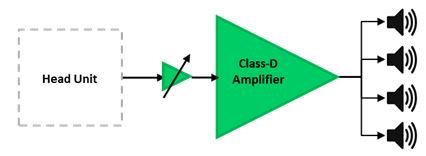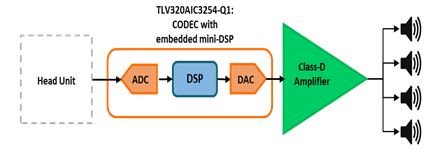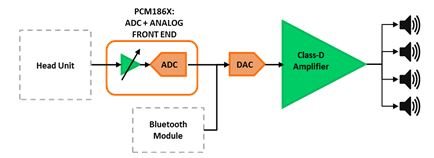-
Automotive External Amplifiers: Why and How?
Automotive External Amplifiers: Why and How?
Victor Ceron
Cars of all sizes and price ranges nowadays are delivering a growing array of entertainment and information features to enhance the driving and riding experience. Today, factory-installed infotainment systems typically combine entertainment, multimedia and driver information into one module. They offer AM/FM and satellite radio, a CD/DVD player for music and video, a navigation system, data and multimedia ports (USB, Bluetooth®, line in, line out, video in), and general and vehicle status information.
Until recently, even the best factory-installed systems provided a subpar listening experience for discerning customers. Upgrading the factory-installed system with vastly improved aftermarket components was a must when users demanded the very best automotive audio quality.
Today, in high-end cars, premium original equipment manufacturers (OEMs) can match, or even surpass, an equivalent aftermarket system in almost every aspect. In addition to the head-unit infotainment system, these high-end systems include powerful factory-installed external amplifiers separate from the head unit to achieve better sound quality.
For low- and mid-end vehicles with basic head-unit implementations and no external amplifier, adding an external aftermarket amplifier vastly improves sound quality; see Figure 1.
 Figure 1 Low-end Automotive Amplifier:
Discrete Preamp and Amplifier
Figure 1 Low-end Automotive Amplifier:
Discrete Preamp and AmplifierIn a typical system, a power amplifier has three sections: the preamp, where the signal comes into the amp and where devices like crossovers and equalizers are located; the power supply, which provides the energy to power the amplifier; and the amplifier itself, which drives the speakers.
The preamp section of the amplifier likely has a gain control stage; this control amplifies the signal coming from the head unit to drive the amplifier to its maximum power level. Depending on the amplifier’s topology, this stage can be implemented with discrete operational amplifiers and discrete components, with a fully integrated analog-to-digital converter (ADC) with analog front end or with a CODEC solution.
Higher-end amplifiers’ preamp stages also perform some level of signal processing to enhance the audio output (like crossover or equalization); this signal processing occurs in the digital domain using a processor or DSP. Fully integrated audio codecs with embedded miniDSP convert the input audio analog signal to digital information, perform the audio signal enhancement, and convert it back to analog, like the system block diagram shown in Figure 2. Alternative topologies include a discrete ADC or digital-to-analog converter (DAC) combo for additional system flexibility; see Figure 3.
 Figure 2 Mid-end Automotive Amplifier:
Integrated Preamplifier with Gain Control and EQ
Figure 2 Mid-end Automotive Amplifier:
Integrated Preamplifier with Gain Control and EQFor the actual amplifier stage, by using Class-D Audio amplifiers the system’s power efficiency can exceed 90% while maintaining top of the line audio fidelity. This improved efficiency leads to significant size, weight and heat reductions; and, although Class-D Audio amplifiers require external inductors, new lower-cost automotive-grade inductors allow system designers keep system cost down and closer to parity to comparable Class-AB based audio systems at a fraction of the size.
 Figure 3 High-end Automotive Amplifier:
Integrated Preamplifier with Analog Gain Control, Crossover and EQ
Figure 3 High-end Automotive Amplifier:
Integrated Preamplifier with Analog Gain Control, Crossover and EQTI’s Class-D car-audio amplifiers exhibit extremely low electromagnetic interference (EMI) levels and are being used in OEM systems with stringent electromagnetic compatibility (EMC) requirements such as CISPR 25-L5, without additional (and costly) filtering or shielding.
Automotive systems are subject to very harsh operating environments and are expected to perform at enhanced levels of reliability. TI’s full-featured automotive Class-D audio amplifiers include built-in load-diagnostics functions for detecting and diagnosing misconnected outputs to help reduce test time during the manufacturing process, along with load-dump protection to withstand high-voltage transients typically present in automotive system power supplies.
Additional Resources
- Check out this blog post on how to keep out-of-band noise down.
- Visit TI’s automotive audio external amplifier portal.
- Learn more about TI’s Class D amplifiers.